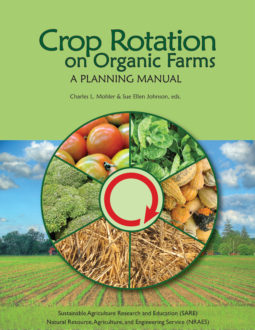This chapter provides a step-by-step procedure for planning crop rotations on an individual farm. The procedure is based on methods used by the panel of expert farmers (chapter 2), supplemented with other sources. It distills what experienced growers do, based on experience, knowledge, and intuition, into a systematic method. For the sake of simplicity, the instructions are written as if the person doing the planning is the manager of the farm.
“The rewards of systematic crop rotation planning increase, however, with the number of crops and the complexity of the fields.”
The crop rotation planning procedure works through a series of steps. You will (1) organize your information, (2) develop a general rotation plan (optional), (3) construct a crop rotation planning map, (4) plan future crop sequences for each section of the farm, and (5) refine your crop sequence plan.
The procedure is easiest for a farm that produces only a few crops and has uniform field conditions, but it is most useful for farms with complex operations. Examples of farms with relatively simple rotation problems include most grain farms and some wholesale vegetable operations, where all of the crops can be grown on all of the fields. The procedure can be used to plan rotations with more crops and multiple soil types, but the process is time-consuming. The rewards of systematic crop rotation planning increase, however, with the number of crops and the complexity of the fields. On farms that grow only a few crops, reasonable rotations can be maintained using a few rules of thumb. With a complex operation, however, a long-term problem can develop without the farmer realizing that the rotation practices are suboptimal. Although the planning procedure described below is divided into many steps, it is not complicated. Simply proceed one step at a time, and you will end up with a plan. Besides helping you develop a plan, working through the procedure will likely give you new insights into your farm and how you manage it. It can also serve as a new baseline and record system for your farm.
“Expert growers simplify their planning by building their rotations around short sequences of two or three crops or cover crops.”
The crop rotation planning process becomes more complex if the crop mix is highly diverse, if you plant the same crop multiple times each season, if you double or triple crop fields, or if the fields vary in their ability to grow various crops. For farms that require a complex cropping plan, using Microsoft Excel spreadsheets instead of paper worktables is advised. These can be downloaded at the links below. The files contain a modified version of this chapter in which the instructions are adapted to worksheets rather than paper tables. For any farm, the computer worksheets will simplify data entry and sorting.
Supplements
- Crop Rotation Planning Procedure [400K .pdf file] - Instructions for using the following spreadsheets instead of paper planning process.
- Crop char0 [.xls file]
- Field char0 [.xls file]
- Summer acres Field char1 [.xls file]
- Linking a Field Map and Spreadsheet in Microsoft Excel [.pdf file]
- Example field map [.xls file]
The procedure described here is not a cookbook recipe. It will not tell you which crop should follow another— for example, to precede a crop with hairy vetch or follow it with potato. Rather, the procedure will help you organize diverse data on the management and biology of the crops you want to grow to define rotations that work for your particular farm. You need to know your fields and your crop mix to use this planner. Only you know the particular goals, problems, and opportunities of your farm operation. The procedure can help you recognize the critical decisions that need to be made, however, and prompt you to make them in a logical order. The worksheets (see instructions and downloads for tables 5.1, 5.2 and 5.3) will help you enter, compare, and sort the information you need to plan a good crop rotation, for each field and for the entire farm.
